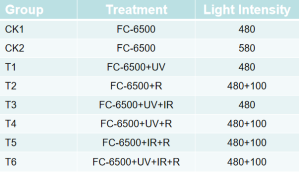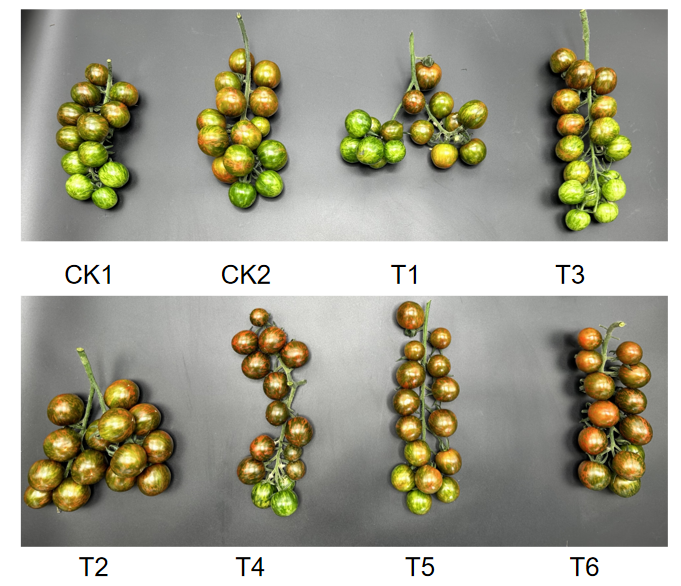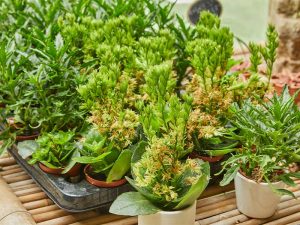Light is fundamental to plant development, influencing processes from photosynthesis to fruit quality. This raises an important question: Is supplemental lighting necessary, and what effect does it have on crop growth?
To explore these questions, we conducted an experiment with tomato plants, examining the effects of ultraviolet (UV), infrared (IR), and Deep Red light.
Experiment Setup
Our experiment aimed to determine how different types and combinations of supplemental lighting affect tomato plants. We selected a single variety of tomato and divided it into eight groups, each subjected to unique lighting conditions using the FC-6500 system. Here are the specific treatments for each group:
Main Lighting Schedule (FC-6500):
- Active from 5:30 a.m. to 5:30 p.m.
Supplemental Lighting Schedules:
- UV Lighting: Initially operated for 5 minutes each hour from 5:30 a.m. to 5:35 p.m. during the first five days. Subsequently, the duration was increased to 10 minutes per hour from 5:30 a.m. to 5:40 p.m.
- IR Lighting: Active for 15 minutes before and after the main lighting period, from 5:15 a.m. to 5:30 a.m. and from 5:30 p.m. to 5:45 p.m.
- Deep Red Lighting: Operated continuously throughout the main lighting period from 5:30 a.m. to 5:30 p.m.
Growing Conditions:
To isolate the impact of the different lighting treatments, all groups were grown under uniform environmental conditions:
- Temperature: Maintained between 22°C and 28°C.
- Humidity: Kept between 65% and 75%.
- Soil Composition: A mix of peat moss, perlite, and vermiculite in a 3:1:1 ratio.
These controlled conditions ensured that any differences in plant growth, yield, and quality could be attributed directly to the variations in lighting treatments.
Experiment Results After 106 Days
1. Fruit Color Development:
- Observations: From the images, it is evident that red light treatment accelerates fruit development and hastens color change, while UV light alone does not have this effect.
- Red Light Effects: The application of red light visibly accelerates fruit development and expedites color change, distinguishing it from the effects of UV light, which does not facilitate these changes.
- IR and Deep Red Combination: Using infrared (IR) and deep red light together markedly speeds up fruit development. This combination promotes earlier ripening and a quicker color transition, resulting in fruits that achieve a market-preferred ripe appearance more swiftly.
- Enhanced Pigmentation: The improved coloration indicates the fruit's readiness for harvest and aligns with market expectations for bright and vibrant tomatoes.
- Mechanisms: IR light penetrates deeply into plant tissues, enhancing growth and maturation, while deep red light specifically boosts pigment changes associated with ripening.
2. Sugar Content:
Data indicates that higher light intensities foster sugar accumulation. Adding UV and deep red light enhances the sugar content, yielding sweeter and more flavorful tomatoes.
- UV Impact: UV light stimulates the production of secondary metabolites, such as flavonoids, enhancing flavor.
- Deep Red Impact: Deep red light boosts photosynthesis and sugar accumulation by increasing carbohydrate production in plants.
3. Yield:
- Enhanced Fruit Quality and Yield: Integrating UV and deep red lights with standard lighting protocols, like the FC-6500, not only increases fruit quantity but also improves overall quality. The combination of UV and IR light results in larger fruits with better coloration, crucial for market appeal.
- Promotion of Flowering in Short-Day Crops: While IR light shows minimal influence on day-neutral crops like tomatoes, it significantly boosts flowering in short-day crops, such as strawberries and cannabis, potentially leading to increased fruit set and higher yields. We are considering a separate experiment focused on the impact of the IR series, particularly the Adlite IR series that emits 730-745 nm IR light, to promote flowering in these plants.
- Consistent and Reliable Results: The use of supplemental lighting leads to consistent improvements in crop yield and quality compared to baseline conditions where no supplemental light is used. Even though high-intensity light naturally increases yield and quality, the addition of UV and deep red light consistently offers superior outcomes in terms of fruit weight and development.
The Impact of UV Light on the Cultivation of Herbaceous Plants
Our research demonstrates that supplemental lighting, especially UV light, is crucial for optimizing plant growth. This conclusion is bolstered by detailed studies, including "The Impact of UV Light on the Cultivation of Herbaceous Plants," which highlights the beneficial effects of UV-A and UV-B light on herb cultivation across several important aspects:
1. Enhanced CBD and Terpene Production: UV-A and UV-B light significantly boost the production of CBD and terpenes by increasing the density of trichomes on plant surfaces. These trichomes not only act as CBD reservoirs but also produce natural compounds that protect against UV radiation. The outcome is herbs that are more potent and aromatic, offering superior flavor and greater medicinal value.
2. Robust Pest and Disease Resistance: UV light stimulates plants to produce specific defensive compounds that naturally deter pests and prevent fungal infections. This biological defense reduces the reliance on synthetic pesticides, promoting more sustainable and organic farming methods.
3. Desirable Plant Morphology: UV exposure alters the physical structure of herb plants, leading to more compact growth and smaller leaves, while also enhancing plant pigmentation. These changes result in visually appealing herbs that are especially attractive to commercial clients and boutique growers who focus on quality and presentation.
By integrating UV lighting into commercial and boutique cultivation settings, growers can not only enhance the quality and appeal of their crops but also boost profitability. This strategic application of UV light capitalizes on the natural properties of plants to foster more effective and quality-centered cultivation practices.
Supplemental Lighting Solutions
Our study conclusively demonstrates the beneficial impact of UV, IR, and Deep Red light on crop optimization. For healthier plants and improved yields, integrating these types of supplemental lighting is crucial. Mars Hydro's ADLITE series offers tailored solutions to meet these specific needs.
ADLITE UV Series
The UV light from the ADLITE UV Series, emitting a spectrum rich in UV-A light (365-370nm), significantly enhances plant vibrancy, flavor, and nutritional value. This UV-A light is particularly effective in boosting THC and CBD levels in herb strains, thereby enhancing their medicinal qualities and overall robustness.
The ADLITE UV Series allows growers to precisely apply UV light at optimal stages of plant growth. This targeted approach promotes the production of valuable secondary metabolites such as flavonoids and anthocyanins. These compounds not only bolster the plant’s natural defenses against pests and diseases but also enhance overall plant health and resilience. This series is an essential tool for modern horticulture, ensuring stronger, healthier plants with improved qualities.
ADLITE IR Series
The ADLITE IR Series uses infrared (IR) lighting to penetrate deeply into plant tissues, stimulating stem growth and flowering. It plays a vital role in regulating growth cycles and metabolic activities, helping plants efficiently transition between growth stages. This optimization leads to better flowering and fruiting, ultimately enhancing yields.
ADLITE Deep Red Series
The ADLITE Deep Red Series is designed to extend flowering periods and increase fruit size, while enriching the coloration of flowers and fruits, thus boosting their aesthetic appeal and nutritional value. This specialized lighting enhances the overall development of plants, ensuring a harvest that is visually impressive and nutritionally rich.
Why Not Simply Incorporate UV and IR into Full Spectrum Lights?
The incorporation of UV and IR light into full spectrum lighting systems is not as straightforward as it may seem, mainly due to concerns over timing control, increased failure rates, and inefficacy.
Timing Control Issues: UV and IR lights play specific roles in plant development, requiring precise timing for their application. UV light is crucial for enhancing disease resistance and phytochemical production; however, overexposure can harm plant DNA and tissues. Similarly, IR light is influential in regulating plant sleep cycles, impacting processes such as flowering and germination. Full spectrum systems that integrate UV and IR often lack the capability to control these light types independently, essential for mimicking natural light cycles and initiating specific plant growth responses at the right moments.
Increased Failure Rates from Complexity: Adding UV and IR capabilities introduces complexity to full-spectrum LED systems. This complexity arises from additional electronic components, including separate circuits and power sources specifically designed to meet the distinct requirements of UV and IR lighting. The inclusion of more components raises the likelihood of manufacturing challenges and potential system failures. Each added element, such as an independent LED driver or control circuit, introduces potential points of failure, which could compromise the entire system's reliability and longevity.
Inefficacy of Embedded UV and IR: The effectiveness of UV and IR lighting depends on the intensity and quality of the emitted light. Plants require specific wavelengths within the UV and IR spectrums to trigger necessary responses like stress defense and flowering. Many integrated systems fail to deliver these critical wavelengths at sufficient intensities. For example, inadequate UV levels may not provide the anticipated benefits for stress signaling, and insufficient IR might not effectively manage photoperiodic responses. As a result, these shortcomings can lead to suboptimal growth conditions, hindering plants from reaching their full potential in yield, quality, and health.
Conclusion
Incorporating UV, IR, and Deep Red supplemental lighting into your cultivation strategy can markedly improve crop growth, yield, and quality. By leveraging these advanced lighting technologies, you can ensure a healthier and more bountiful harvest.









